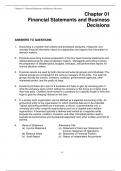Exam (elaborations)
Chapter 01 Financial Statements and Business Decisions
- Module
- Institution
Chapter 01 Financial Statements and Business Decisions ANSWERS TO QUESTIONS 1. Accounting is a system that collects and processes (analyzes, measures, and records) financial information about an organization and reports that information to decision makers. 2. Financial accounting invo...
[Show more]



